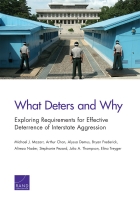PDF file 4.3 MB
Research Question
What are the requirements of effective extended deterrence of large-scale military aggression?
The challenge of deterring territorial aggression, which for several decades has been an afterthought in U.S. strategy toward most regions of the world, is taking on renewed importance. An increasingly belligerent Russia is threatening Eastern Europe and the Baltic States with possible aggression, conventional and otherwise. China is pursuing its territorial ambitions in the East and South China Seas with greater force, including the construction of artificial islands and occasional bouts of outright physical intimidation. North Korea remains a persistent threat to the Republic of Korea (ROK), including the possibility of large-scale aggression using its rapidly advancing nuclear arsenal.
Yet the discussion of deterrence — as a theory and practical policy requirement — has lagged in U.S. military and strategy circles. The authors aim to provide a fresh look at the subject in this context, with two primary purposes: to review established concepts about deterrence, and to provide a framework for evaluating the strength of deterrent relationships. For greater focus, they concentrate on a specific category or form of deterrence: extended deterrence of interstate aggression. The authors consider the requirements for the United States to deter potential aggressors abroad from attacking U.S. allies or other countries in large-scale conventional conflicts. Examples include Russian attacks on the Baltic States and a North Korean assault on the ROK.
The study stems from a specific research question: What are the requirements of effective extended deterrence of large-scale military aggression? The focus is therefore on the criteria that tend to distinguish successful from unsuccessful efforts to deter interstate aggression.
Key Findings
Potential aggressors' motivations are highly complex and typically respond to many variables whose interaction is difficult to anticipate.
Opportunism in aggression seems less common than desperation through paranoia about growing threats to security or status. Large-scale aggression tends to emerge as a last resort based on intense fears rather than an opportunistic grab.
Clarity and consistency of deterrent messaging are essential. Half-hearted commitments risk being misperceived.
The principle of "firm but flexible" is very important: Leaving an adversary without a way out is not an effective way to sustain deterrence. Compromise and concession are part of any successful extended deterrence of large-scale aggression.
Multilateral deterrent contexts are especially dangerous. Deterring an aggressive ally and an opposing major power at the same time is extremely difficult.
The foundation for deterrence outcomes — that is, the initial and in some ways decisive variable — is provided by aggressor motivations. Weakly motivated aggressors are easy to deter; intensely motivated ones, whose level of threat perception may verge on paranoia, can be impossible to deter.
The first step toward bolstering deterrence is to manage the motives of a potential aggressor. Doing so often requires concessions, as well as steps to shape the surrounding geopolitical context to ease its concerns and also raise the political costs of aggression.
Recommendations
Assess the motives of potential aggressors and ease security concerns. In Europe, this could include avoiding deployment of the most provocative U.S. systems in or near Eastern Europe, thinning Russian and Baltic forces, and working on a successor to the Conventional Forces in Europe Treaty.
Work to create a context hostile to aggression. In Europe, this could include engaging in efforts to strengthen the political foundations of the North Atlantic Treaty Organization (NATO), reiterating commitments to Article V countries, and reinforcing the norm of nonaggression and a committed aggression response.
Seek clarity in what the United States pledges to deter and in its reaction to aggression. In Europe, this could include reaffirming the Baltics' Article V status and aggression response and outlining options in response to aggression (including military, political, and economic consequences).
Take specific steps that reinforce successful deterrence criteria. In Europe, this could include promoting visits and statements of support from key U.S. leaders, strengthening and diversifying relationships with the Baltics, promoting investment from the United States and NATO and continued diplomacy, and strengthening communication and crisis management within NATO and between NATO and Russia.
Deploy or support capabilities that signal the seriousness of U.S. commitment. In Europe, this could include working with NATO allies to fund new defensive capabilities, reinforcing existing NATO battalions in and around the Baltics, and investing in capabilities for successful combined arms operations in Europe (especially in ground force capabilities).

No comments:
Post a Comment